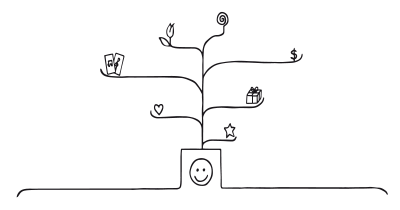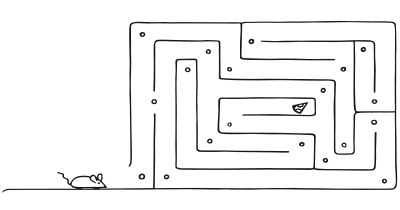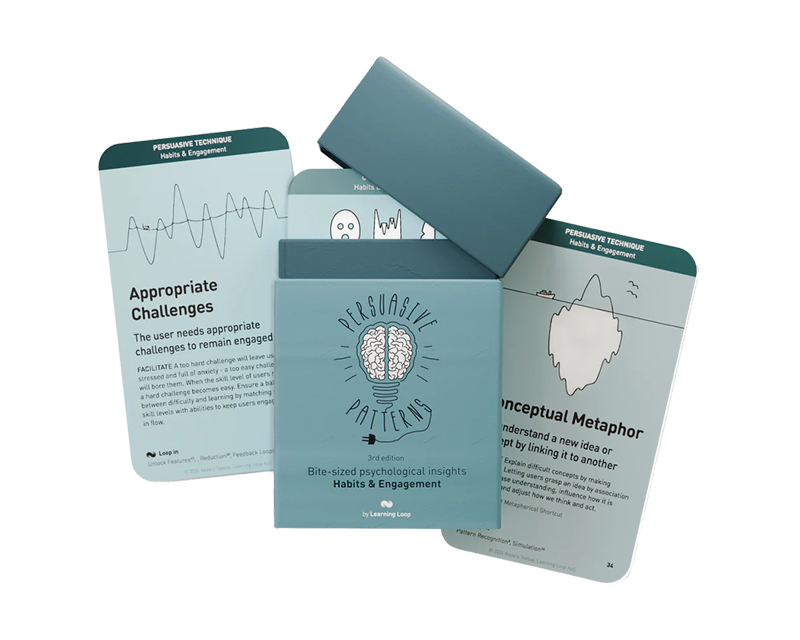Persuasive Patterns: Influence
Humor Effect
Information presented with humor is more likely to motivate and be remembered

The Humor Effect refers to the tendency for information presented with humor to be more memorable and engaging. This pattern leverages the psychological impact of humor to capture attention, evoke positive emotions, and create a lasting impression.
In a lecture on a complex scientific topic, a professor drones on in a monotone voice, listing technical terms and figures. While you try to focus, your eyelids grow heavy, and the information starts to blur. Suddenly, the professor cracks a witty joke about a scientific mishap, and the room erupts in laughter. Your attention is instantly recaptured, and the technical term you were struggling to remember clicks into place. Humor acts as a cognitive cue, jolting us out of passive listening and enhancing our focus on the information being presented.
Similarly, imagine the onboarding process for a budgeting app, featuring text-heavy screens filled with complex financial terms, might leave users feeling overwhelmed and unsure of how to proceed. However, an app that incorporates lighthearted humor into the onboarding process, perhaps through the use of a friendly mascot or witty messages, can make the experience more engaging and memorable. Humor in online learning environments can increase user satisfaction and motivation, ultimately leading to better learning outcomes. In this way, the Humor Effect can transform a potentially tedious task into a more positive and productive experience.
The study
A seminal study conducted by Schmidt (1994) investigated the impact of humor on memory retention. The study involved two groups of participants who were presented with different sets of sentences: one group was exposed to sentences containing humorous content, while the other group was exposed to non-humorous content.
The study found that participants exposed to humorous sentences demonstrated significantly higher recall rates compared to those who read non-humorous sentences. Specifically, the study revealed that humor’s effect on memory was more pronounced for younger participants and those who considered themselves to have a strong sense of humor.
This finding highlights the potential of humor to enhance information retention and create lasting impressions, making it a powerful tool in design and communication.
Schmidt, S. R. (1994). Effects of humor on sentence memory. Journal of Experimental Psychology: Learning, Memory, and Cognition, 20(4), 953–967.
Humor disarms our defenses and captures attention. By incorporating humor into product design, marketing, or communication, companies can engage users more effectively. Humor triggers positive emotions, reduces stress, and creates a more enjoyable experience, which can foster brand loyalty, increase conversion rates, and encourage positive word-of-mouth.
Humor can break the ice in a tense conversation, lighten the mood during a stressful presentation, and even make us remember information more easily. This phenomenon, known as the Humor Effect, has been explored by psychologists and marketers alike, revealing its effectiveness in influencing behavior and enhancing learning.
At the core of the Humor Effect lies the Elaboration Likelihood Model (ELM). ELM proposes two main routes to persuasion: central _and peripheral_. The central route involves deep processing of information, while the peripheral route relies on mental shortcuts. Humor strategically employed can nudge users towards the central route by:
- Boosting attention and arousal
A well-timed joke or humorous element acts as a cognitive jolt, grabbing attention and pulling users out of passive processing. This increased arousal enhances their focus on the information being presented. - Elevating mood and liking
Humor can improve a user’s mood and create a sense of connection with the communicator or message. This positive state can motivate users to engage more deeply with the content, leading to better information processing. - Encouraging elaboration
A witty turn of phrase or a humorous illustration might prompt users to think more critically about the information and connect it with their existing knowledge and experiences. This deeper processing strengthens memory and understanding.
Beyond the ELM framework, the Humor Effect leverages several key psychological principles:
- Cognitive ease
Humor simplifies complex topics, reducing the cognitive load associated with processing information. Studies by Schmidt (1994, 2001) demonstrate that humorous elements enhance memory for sentences and cartoons. When people find something funny, they relax, facilitating cognitive processing and information retention. - Associative learning
Humor fosters positive emotional responses that create an association between the information and those feelings. This emotional connection strengthens memory retention, as demonstrated in advertising research by McGhee (1979) and Apter (1982). When a brand uses humor in its ads, consumers might associate the positive emotions from the ad with the brand, reinforcing its message and encouraging recall. - Arousal theory
Humor triggers emotional responses that heighten arousal. Arousal theory suggests that heightened arousal can enhance cognitive performance, particularly memory retention (Martin, 2007). By engaging users emotionally, humor helps to ensure that the information presented is not only remembered but also associated with a positive emotional state. - Attention and engagement
Humor captures attention and sustains engagement. The positive emotional response triggered by a humorous stimulus can extend users’ attention spans, making them more likely to focus on and engage with the content (Ziv, 1988). This increased engagement, as highlighted by Klein & Kuiper (2006) and Cann & Calhoun (2001), helps solidify the information in their memory.
Humor can even be used to deliver unpleasant information. The emotional response to humor can lift the emotional block that might hinder processing difficult information, allowing for better storage and retrieval.
Finally, humor can enhance attractiveness through a cognitive bias called the Halo Effect. This bias leads people to associate positive traits with others who exhibit humor, making them appear smarter, nicer, or even more attractive.
Designing products with the Humor Effect
The Humor Effect goes beyond making users laugh. Research shows it can enhance information retention, improve user experience, and ultimately drive engagement. Integrating humor effectively requires a balanced approach. Here’s how to seamlessly weave humor into your product design:
Understanding your audience’s sense of humor is essential, as humor is subjective. This prevents jokes from falling flat or offending users. Consider how a joke that amuses your friends on a Saturday night might not resonate in a Monday morning stand-up meeting. Knowing your audience helps tailor humor effectively.
Embed humor throughout the user journey. Lighthearted messages or amusing visuals at touchpoints like loading screens or error messages can create a positive and engaging experience. This consistency makes the product feel more relatable and enjoyable, encouraging users to explore further.
Tailor humor to suit the specific context and audience. A joke or reference that resonates with the target audience can create a deeper connection. For instance, an e-commerce site for tech enthusiasts might use technology-themed puns or references. Speaking the user’s language through humor fosters a sense of familiarity.
Humor can mitigate frustration or setbacks. A humorous or playful response to an error message can lighten the mood and improve user perception. This can turn a negative experience into a more positive one, fostering a better relationship with the product.
Ensure that humor enhances, not detracts from, the product’s functionality. For instance, a software application might use humorous pop-up messages to provide helpful tips or feedback, making the experience enjoyable while conveying valuable information.
Experiment with different forms of humor to see what resonates best with your audience. Conduct user testing to gauge humor’s impact on behavior and engagement, allowing you to refine your approach. An educational app might test different humorous illustrations and iterate based on user feedback.
Maintain humor that aligns with your overall brand identity. Consistency builds trust and familiarity. A playful brand can weave humor throughout its messaging and design, while a serious brand might use humor sparingly to avoid confusing the audience.
Consider incorporating funny illustrations, animations, or memes that align with the product’s theme and message. Imagine a productivity app using a cartoon character to represent task completion stages, adding a touch of humor to the experience
Ethical recommendations
The Humor Effect, while powerful, can be misused in ways that negatively impact users. For instance, humor can be used to trivialize serious matters, leading to misunderstandings or even distress.
Jokes about sensitive topics or situations, such as health issues or financial struggles, can lead to unintended harm, eroding trust in the product or brand. Additionally, humor might detract from the overall functionality or message of the product, resulting in a lack of clarity or confusion. Overuse of humor, especially when it feels forced or out of place, can also diminish the perceived credibility of the product, undermining user confidence.
Jokes that reflect cultural insensitivity or perpetuate stereotypes can alienate and offend users, further damaging the product’s reputation.
To ensure the Humor Effect is used ethically and in a user-centric manner, consider the following recommendations:
- Know your audience
Always prioritize user research to understand your target audience’s sense of humor. Avoid humor that might be culturally insensitive or offensive to specific groups. - Context is key
Tailor your humor to the specific situation and message. A lighthearted joke might be appropriate in a casual setting, but a serious topic requires a more respectful tone. - Humor should uplift, not exploit
Use humor to enhance the user experience, not exploit their vulnerabilities. Humor should never be used to shame or manipulate users into taking unwanted actions. - Be transparent
Be upfront about your intentions. Avoid using humor to disguise misleading or deceptive information.
Real life Humor Effect examples
Duolingo
The language-learning app incorporates humor throughout its user journey. From amusing reminders to engaging push notifications, Duolingo’s playful tone keeps users coming back. This consistent use of humor reinforces learning objectives, making language acquisition enjoyable and memorable.
Mailchimp
The email marketing platform integrates humor into its interface design. For example, its playful copywriting in error messages or notifications, such as “Oops, something went wrong,” with a lighthearted tone, softens potential frustration. Additionally, the visual mascot, a cartoon chimp named Freddie, provides a cheerful presence, making the platform more approachable.
Grammarly
The writing assistant software incorporates humor into its design through its interface feedback. For instance, when users make grammar mistakes, Grammarly’s corrections can include lighthearted comments, such as, “Oops, that needs a fix,” creating a more engaging experience.
Trigger Questions
- Does the humor serve a purpose?
- Do we understand our audience's sense of humor?
- Does the humor align with our brand identity?
- Is this the right moment for humor?
- Is humor enhancing or detracting from the product's functionality?
- Does humor mitigate user frustration or setbacks?
- Are we balancing subtlety and impact?
Pairings
Humor Effect + Storytelling
Weave lighthearted narratives to captivate attention. In digital products, integrating humorous anecdotes within tutorials or educational content can make learning more enjoyable, leading to better retention. For example, a language-learning app might incorporate amusing dialogues or scenarios, making users laugh while absorbing vocabulary and grammar.

Information presented with humor is more likely to motivate and be remembered

We engage, understand, and remember narratives better than facts alone
Humor Effect + Delighters
Visual humor, such as funny illustrations or playful animations, can significantly enhance the Humor Effect. This combination creates a dual-sensory experience, engaging both visual and cognitive processing. In an educational app, incorporating cartoon characters to guide users through lessons, or using humorous animations to illustrate concepts, can increase engagement and information retention.

Information presented with humor is more likely to motivate and be remembered

We remember and respond favorably to new, unexpected, and playful pleasures
Humor Effect + Framing Effect
Humorous framing can recontextualize complex or dry content into an engaging narrative. For instance, a financial planning app might frame budgeting advice humorously, presenting it as “how not to blow your savings on avocado toast,” making the topic more relatable and memorable.

Information presented with humor is more likely to motivate and be remembered

The way a fact is presented greatly alters our judgment and decisions
Humor Effect + Curiosity Effect
A witty remark or humorous teaser can pique users’ interest, leading them to seek more information. For example, a travel website might include humorous headlines like “10 Destinations Where You Won’t Have to Use Your Passport,” enticing users to click through and discover more.

Information presented with humor is more likely to motivate and be remembered

We crave more when teased with a small bit of interesting information
Humor Effect + Social Proof
Humor can make social proof more relatable and engaging. Testimonials or reviews presented humorously can capture users’ attention and encourage them to trust the product or service. An e-commerce platform might showcase humorous customer reviews, emphasizing both the quality of the product and the positive experience of previous buyers.

Information presented with humor is more likely to motivate and be remembered

We assume the actions of others in new or unfamiliar situations
Humor Effect + Positive Mimicry
Humor can make mimicry more approachable, encouraging users to emulate positive behaviors. A fitness app might include humorous motivational quotes or cartoons, lightening the mood and making the idea of exercise more appealing. This can foster a sense of camaraderie, prompting users to follow positive habits.

Information presented with humor is more likely to motivate and be remembered

We learn by comparing our behavior with the actions of others
Humor Effect + Reciprocity
Humor can foster a sense of goodwill, making users more receptive to reciprocal actions. A software service might include humorous thank-you messages or lighthearted rewards, encouraging users to engage further. This positive reinforcement can create a cycle of reciprocity, where users feel more inclined to return the favor by using the product.

Information presented with humor is more likely to motivate and be remembered

We feel obliged to give when we receive
A brainstorming tool packed with tactics from psychology that will help you build lasting habits, facilitate behavioral commitment, build lasting habits, and understand the human mind. It is presented in a manner easily referenced and used as a brainstorming tool.
Get your deck!- Effects of humor on sentence memory by Schmidt
- Humor: Its origin and development by McGhee
- Schmidt, S. R. (1994). Effects of humor on sentence memory. Journal of Experimental Psychology: Learning, Memory, and Cognition, 20(4), 953–967.
- Schmidt, S. R., & Williams, A. R. (2001). Memory for humorous cartoons. Memory & Cognition, 29(2), 305–311.
- McGhee, P. E. (1979). Humor: Its effects on response to advertising. Journal of Advertising, 8(4), 11-16.
- Apter, M. J. (1982). The effects of humor in advertising on product attitude and purchase intention. Journal of Marketing Research, 19(4), 131-138.
- Cann, A., & Calhoun, L. G. (2001). Perceived personality associations with differences in sense of humor: Stereotypes of hypothetical others with high or low senses of humor. Humor, 14(2), 117–130.
- Martin, R. A. (2007). The psychology of humor: An integrative approach. Academic Press.
- Klein, A. B., & Kuiper, N. A. (2006). Humor styles, peer relationships, and bullying in middle childhood. Humor, 19(4), 383–404.
- Ziv, A. (1988). Teaching and learning with humor: Experiment and replication. Journal of Experimental Education, 57(1), 4–15.
- Petty, R. E., & Cacioppo, J. T. (1986). The elaboration likelihood model of persuasion. Communication and persuasion, 1, 1-24.
- Martin, I., Davey, P., & Fahy, P. (2003). Humor, cognitive style, and learning from a multimedia lecture. British Journal of Educational Psychology, 73(3), 341-354.

